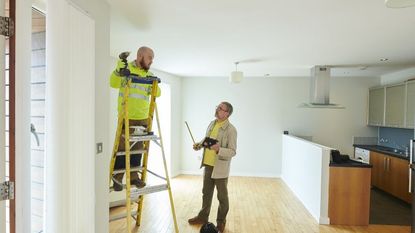Buy-to-let landlords face a £17.9bn bill for energy efficiency
Research from Knight Frank shows buy-to-let landlords could face a huge bill to upgrade their properties to an EPC rating of C or above


The deteriorating outlook for house prices, coupled with the rising costs of being a landlord are two factors driving investors out of the buy-to-let market.
And more landlords could be looking to sell their properties soon, as they face a combined bill of £17.9bn to make their properties more energy efficient, according to data from estate agent Knight Frank.
The government is currently consulting on legislation that would require all rental properties to have an EPC rating of C or above by 31 December 2025 for new tenancies and by 31 December 2028 for existing tenancies.
Subscribe to MoneyWeek
Subscribe to MoneyWeek today and get your first six magazine issues absolutely FREE

Sign up to Money Morning
Don't miss the latest investment and personal finances news, market analysis, plus money-saving tips with our free twice-daily newsletter
Don't miss the latest investment and personal finances news, market analysis, plus money-saving tips with our free twice-daily newsletter
Under current regulations, tenanted properties are required to have an EPC rating of E or above. Currently, around 60% of the 4.8 million households in the private rented sector have an EPC rating of D or below.
On average the cost of upgrading a property to an EPC rating of C is around £9,260.
While 13% of renters are willing to pay a premium for a low-carbon property, the average annual rent in 40% of local authorities would not cover the £9,260 required to bring a property up to the government’s new proposed rating.
A third of buy-to-let landlords expect to exit the market in 2023
A survey by the National Residential Landlords Association (NRLA) revealed a third of buy-to-let landlords expect to sell some of their properties this year. That’s the highest level of planned divestment in over six years.
Many buy-to-let landlords began exiting the market due to legislative changes even before the cost of living crisis and higher mortgage costs started to take a chunk out of their profits.
Indeed, data from Hamptons International shows a landlord would now need a rental yield of 4% to turn a profit. Back in 2020, investors could make a profit with a yield of 2%.
Higher-rate taxpayers have it worse – they need a yield of 5% to turn a profit.
More and more people are getting pushed into higher tax bands due to fiscal drag, which is leaving landlords with higher tax bills.
Additionally, changes made to mortgage interest tax relief made in 2020 mean landlords are no longer able to claim tax back on their mortgage repayments, receiving refunds only at the 20% basic rate instead.
What’s more, the changes made to the regulation means that landlords can be taxed even if they make a loss.
“Faced with this additional intense pressure on already stretched finances, landlords will likely be scrambling to protect their investments, and some will be weighing up their options,” says Brian Murphy, head of lending at Mortgage Advice Bureau.
The cost of making a home more energy efficient could run into the tens of thousands, and MAB research found many landlords will going to struggle to meet this.
“There is a dwindling incentive for landlords to stay in the market, as some risk making monthly losses on their property assets,” continues Murphy.
These costs will be harder to meet than ever before. Data from online property specialist My Auction showed that mortgage payments are now exceeding rental incomes as interest rates on buy-to-let mortgages rise due to interest rate hikes from the Bank of England.
Additionally, house price growth has been slowing over the last six months, and the OBR expects house prices will fall by 10% by 2024 due to the impact of higher borrowing costs and the cost of living crisis will have on the housing market.
While there are savings to be made by making a property more energy efficient, if this legislation passes landlords could look to downsize their portfolios or exit the sector.
Those still looking to buy will likely drive up demand for newer, more energy-efficient homes with better EPC ratings.
And if you are interested in purchasing a buy-to-let property, it’s more important than ever to look into the best areas for buy-to-let in the UK to make sure you’re getting the best possible return on your money.
Nic studied for a BA in journalism at Cardiff University, and has an MA in magazine journalism from City University. She joined MoneyWeek in 2019.
-
-
 Investment trust discounts hit 2008 levels. Here’s how to profit
Investment trust discounts hit 2008 levels. Here’s how to profitInvestment trust discounts have risen to levels not seen since 2008, here are three trusts looking to buy to profit.
By Rupert Hargreaves Published
-
 A luxury stock to buy at a high street price
A luxury stock to buy at a high street priceInvestors wrongly consider Watches of Switzerland a high-street outlet.
By Dr Matthew Partridge Published
-
 Investing in wine: how Cru Wine is reaching new audiences
Investing in wine: how Cru Wine is reaching new audiencesTips Gregory Swartberg, founder of fine wine specialist Cru Wine, talks to Chris Carter about how to start a wine collection
By Chris Carter Published
-
 Small companies with big potential
Small companies with big potentialMichael Taylor of Shifting Shares reviews his 2023 picks and highlights more promising minnows.
By Michael Taylor Published
-
 The MoneyWeek portfolio of investment trusts – July 2023 update
The MoneyWeek portfolio of investment trusts – July 2023 updateTips A decade ago we set up the MoneyWeek portfolio of investment trusts. They remain a compelling long-term bet says Rupert Hargreaves
By Rupert Hargreaves Published
-
 Women lead the way with ethical investments
Women lead the way with ethical investmentsDemand for more ethical investments has soared – and women are more likely to opt for them. Annabelle Williams, personal finance specialist at Nutmeg, takes a look at why.
By Annabelle Williams Published
-
 BoE: Mortgage payments to rise by £220 a month for households
BoE: Mortgage payments to rise by £220 a month for householdsMillions of households can expect a mortgage spike of around £200 a month - and some may even reach a extra £1,000 a month, the Bank of England warns
By Marc Shoffman Published
-
 What happened to Thames Water?
What happened to Thames Water?Thames Water, the UK’s biggest water company could go under due to mismanagement and debt. We look into how the company got itself into this position, and what investors should expect.
By Simon Wilson Last updated
-
 Where to invest in the metals that will engineer the energy transition
Where to invest in the metals that will engineer the energy transitionA professional investor tells us where he’d put his money. This week: John Ciampaglia, manager of the Sprott Energy Transition Materials UCITS ETF.
By Nicole García Mérida Published
-
 How investors can profit from high food prices
How investors can profit from high food pricesThe latest furore over grocery prices will die down, says David Stevenson. But the long-term outlook for soft commodities remains bullish. These are the stocks investors can buy to profit from high food prices.
By David J Stevenson Published









